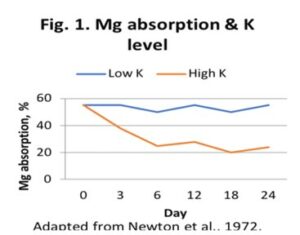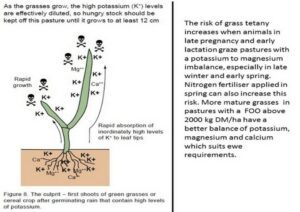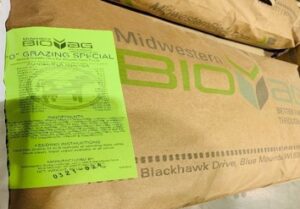
Signs of grass tetany are excessive alertness, nervousness, and reduced feed intake. As tetany progresses, cattle may convey a staggered, uncoordinated walk, salivate profusely and drop with convulsive spasms. Death can occur as soon as 2 or 3 hours after the first symptoms are present. A great way to avoid grass tetany is to avoid grazing cattle on new grass until it is 4 to 6 inches tall because magnesium is less available in very immature plants.
Another prevention method is to feed legumes hay or graze mixed legume-grass pastures since legumes are higher in magnesium than grasses. There is also the option of feeding a magnesium supplement to the cattle to prevent magnesium deficiency, leading to grass tetany.
 Product of the Week: “O” Grazing Special
Product of the Week: “O” Grazing Special
Speaking of grass tetany, the “O” Grazing special provides high levels of supplemental magnesium. This mineral blend prevents grass tetany. This mixed mineral is a perfect free-choice option if the herd is grazing out on pasture. Not only does it provide magnesium, but it also provides calcium and phosphorus from highly available sources. It provides selenium from selenium yeast, and contains sulfate forms of trace minerals and Redmond natural trace mineral salt. Icelandic kelp is also thrown into this, which is a source of over 60 trace minerals and vitamins. With all these amazing ingredients mixed together, many benefits arise. This mineral blend helps promote reproductive health, immune system function and hoof health. Great product to help balance all nutrients they might not be getting out on pasture.
How can farms prevent grass tetany? Comments from our Consultants:
“Most dairymen make sure to have the cattle go to pasture with a full stomach” – Scott Wood
“At my former job, we put Chrystalyx High Magnesium tubs out for cattle to lick on when letting out to pasture. This was usually done a week before turning them out to pasture. That was beef cattle. They need extra magnesium.” – Merlin Hershberger
“Number one: Get cows fed in the morning before turning them out to pastures. It’s important that cattle don’t go out to the pasture hungry, as they could overindulge on the pasture grass and problems such as grass tetany arise. Number two: only have cows out on pasture for a short time, for the first couple of times. This helps to acclimate them and they can gradually be out there for longer periods of time. Number 3: Supplement magnesium. “O” Grazing Special is a great way to supplement magnesium” – Bob Johnson



